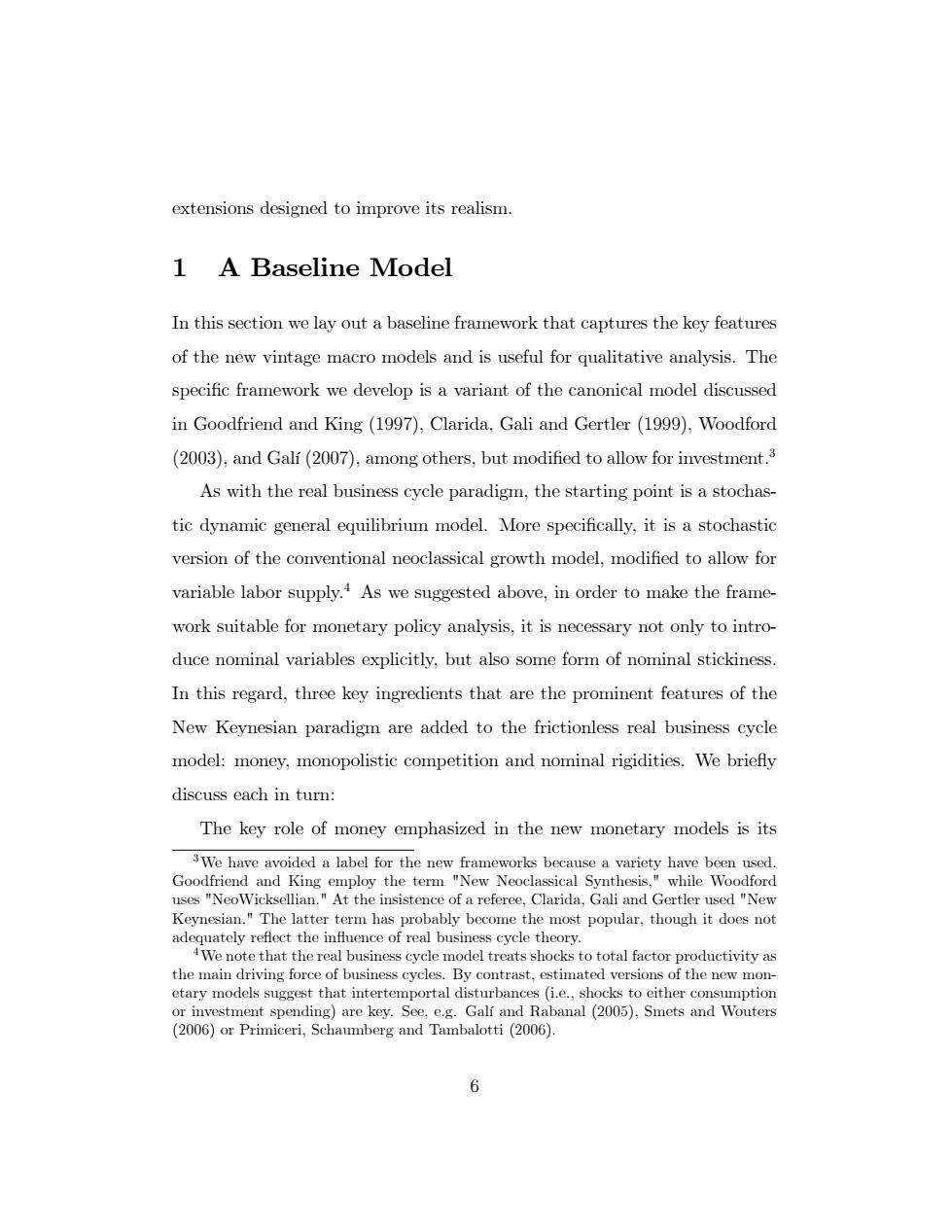正在加载图片...

extensions designed to improve its realism. 1 A Baseline Model In this section we lay out a baseline framework that captures the key features of the new vintage macro models and is useful for qualitative analysis.The specific framework we develop is a variant of the canonical model discussed in Goodfriend and King (1997),Clarida,Gali and Gertler(1999),Woodford (2003),and Gali (2007),among others,but modified to allow for investment.3 As with the real business cycle paradigm,the starting point is a stochas- tic dynamic general equilibrium model.More specifically,it is a stochastic version of the conventional neoclassical growth model,modified to allow for variable labor supply.4 As we suggested above,in order to make the frame- work suitable for monetary policy analysis,it is necessary not only to intro- duce nominal variables explicitly,but also some form of nominal stickiness. In this regard,three key ingredients that are the prominent features of the New Keynesian paradigm are added to the frictionless real business cycle model:money,monopolistic competition and nominal rigidities.We briefly discuss each in turn: The key role of money emphasized in the new monetary models is its 3We have avoided a label for the new frameworks because a variety have been used. Goodfriend and King employ the term "New Neoclassical Synthesis,"while Woodford uses "NeoWicksellian.At the insistence of a referee.Clarida.Gali and Gertler used "New Keynesian."The latter term has probably become the most popular,though it does not adequately reflect the influence of real business cycle theory. 4We note that the real business cycle model treats shocks to total factor productivity as the main driving force of business cycles.By contrast,estimated versions of the new mon- etary models suggest that intertemportal disturbances(i.e.,shocks to either consumption or investment spending)are key.See,e.g.Gali and Rabanal(2005),Smets and Wouters (2006)or Primiceri,Schaumberg and Tambalotti (2006). 6extensions designed to improve its realism. 1 A Baseline Model In this section we lay out a baseline framework that captures the key features of the new vintage macro models and is useful for qualitative analysis. The speciÖc framework we develop is a variant of the canonical model discussed in Goodfriend and King (1997), Clarida, Gali and Gertler (1999), Woodford (2003), and GalÌ (2007), among others, but modiÖed to allow for investment.3 As with the real business cycle paradigm, the starting point is a stochastic dynamic general equilibrium model. More speciÖcally, it is a stochastic version of the conventional neoclassical growth model, modiÖed to allow for variable labor supply.4 As we suggested above, in order to make the framework suitable for monetary policy analysis, it is necessary not only to introduce nominal variables explicitly, but also some form of nominal stickiness. In this regard, three key ingredients that are the prominent features of the New Keynesian paradigm are added to the frictionless real business cycle model: money, monopolistic competition and nominal rigidities. We brieáy discuss each in turn: The key role of money emphasized in the new monetary models is its 3We have avoided a label for the new frameworks because a variety have been used. Goodfriend and King employ the term "New Neoclassical Synthesis," while Woodford uses "NeoWicksellian." At the insistence of a referee, Clarida, Gali and Gertler used "New Keynesian." The latter term has probably become the most popular, though it does not adequately reáect the ináuence of real business cycle theory. 4We note that the real business cycle model treats shocks to total factor productivity as the main driving force of business cycles. By contrast, estimated versions of the new monetary models suggest that intertemportal disturbances (i.e., shocks to either consumption or investment spending) are key. See, e.g. GalÌ and Rabanal (2005), Smets and Wouters (2006) or Primiceri, Schaumberg and Tambalotti (2006). 6